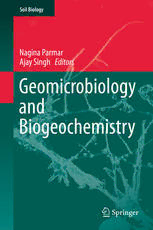
Geomicrobiology and Biogeochemistry PDF
Preview Geomicrobiology and Biogeochemistry
Soil Biology Nagina Parmar Ajay Singh Editors Geomicrobiology and Biogeochemistry Soil Biology Volume 39 Series Editor AjitVarma,AmityInstituteofMicrobialTechnology, Amity University Uttar Pradesh, Noida, UP, India For furthervolumes: http://www.springer.com/series/5138 ThiSisaFMBlankPage Nagina Parmar (cid:129) Ajay Singh Editors Geomicrobiology and Biogeochemistry Editors NaginaParmar AjaySingh DepartmentofChemistryandBiology LystekInternationalInc. RyersonUniversity Cambridge Toronto Ontario Ontario Canada Canada ISSN1613-3382 ISSN2196-4831(electronic) ISBN978-3-642-41836-5 ISBN978-3-642-41837-2(eBook) DOI10.1007/978-3-642-41837-2 SpringerHeidelbergNewYorkDordrechtLondon LibraryofCongressControlNumber:2013956629 ©Springer-VerlagBerlinHeidelberg2014 Thisworkissubjecttocopyright.AllrightsarereservedbythePublisher,whetherthewholeorpart of the material is concerned, specifically the rights of translation, reprinting, reuse of illustrations, recitation,broadcasting,reproductiononmicrofilmsorinanyotherphysicalway,andtransmissionor informationstorageandretrieval,electronicadaptation,computersoftware,orbysimilarordissimilar methodologynowknownorhereafterdeveloped.Exemptedfromthislegalreservationarebriefexcerpts inconnectionwithreviewsorscholarlyanalysisormaterialsuppliedspecificallyforthepurposeofbeing enteredandexecutedonacomputersystem,forexclusiveusebythepurchaserofthework.Duplication ofthispublicationorpartsthereofispermittedonlyundertheprovisionsoftheCopyrightLawofthe Publisher’s location, in its current version, and permission for use must always be obtained from Springer.PermissionsforusemaybeobtainedthroughRightsLinkattheCopyrightClearanceCenter. ViolationsareliabletoprosecutionundertherespectiveCopyrightLaw. The use of general descriptive names, registered names, trademarks, service marks, etc. in this publicationdoesnotimply,evenintheabsenceofaspecificstatement,thatsuchnamesareexempt fromtherelevantprotectivelawsandregulationsandthereforefreeforgeneraluse. While the advice and information in this book are believed to be true and accurate at the date of publication,neithertheauthorsnortheeditorsnorthepublishercanacceptanylegalresponsibilityfor anyerrorsoromissionsthatmaybemade.Thepublishermakesnowarranty,expressorimplied,with respecttothematerialcontainedherein. Printedonacid-freepaper SpringerispartofSpringerScience+BusinessMedia(www.springer.com) Preface Earth sustains an immense diversity of prokaryotic and eukaryotic organisms. Microorganismsplayanessentialroleinthefunctioningandsustainingofallnatural ecosystems including biogeochemical cycling of nutrients. Biotechnology has becomeanimportanttoolformanipulatingandutilizingmicroorganismsandplants andprovidingnewapproachesinvariousindustriesincludingpetroleum,food,feed, pharmaceutical,detergent,andpulpandpaper.Newstrainsarecontinuouslybeing exploredandgeneticorenzymaticfunctionsareoftenreconstructedthroughmolec- ularrecombinationandproteinengineeringtechniquestoincreasethegeneexpres- sion and metabolic productivity of industrially important organisms. The unique characteristicsofthesemicrobesarewidelyutilizedforindustrialapplicationssuch asenzymesandchemicalproduction,wastetreatmentandrecycling,bioremediation of industrial pollutants in soils and aquifers, enhanced petroleum oil recovery, biomining, and soil fertility. Biochemical and molecular tools are continuously being developed in an attempt to evaluate community structures with ecosystem functionsandtodevelopappropriateindustrialapproaches. ThisvolumeoftheSoilBiologyseries,GeomicrobiologyandBiogeochemistry, is a selection of topics related to biological processes with an emphasis on their industrialapplications.Itgivesanoverviewofvariousaspectsingeomicrobiology andbiotechnologyincludingtopicssuchasbiomining,bioremediation,biotechno- logical applications of some extremophiles, subsurface petroleum microbiology, enhancedoilrecoveryusingmicrobesandtheirproducts,metalextraction,andsoil nutrientcyclingandplantnutrition. Expertsintheareaofgeomicrobiologyandenvironmentalsciencesfromdiverse institutions worldwide have contributed to this book, which should prove to be usefultostudents,teachers,andresearchersinthedisciplinesofsoilandgeological sciences,microbiology,environmentalengineering,andbiotechnology. We gratefully acknowledge the cooperation and support of all the contributing authors,theserieseditorProf.AjitVarma,andDr.JuttaLindenbornthroughoutthe preparationofthisvolume. Toronto,ON,Canada Dr.NaginaParmar Cambridge,ON,Canada Dr.AjaySingh v ThiSisaFMBlankPage Contents 1 Geobiotechnology. . . . . . . . . . . . . . . . . . . . . . . . . . . . . . . . . . . . . . 1 NaginaParmarandAjaySingh 2 NovelMolecularToolstoAssessMicrobialActivityinContaminated Environments. . . . . . . . . . . . . . . . . . . . . . . . . . . . . . . . . . . . . . . . . 17 NadineLoickandChristopherWeisener 3 AdvancedMolecularandMicrospectroscopyToolboxfor DecipheringSoilDiazotrophDiversity. . . . . . . . . . . . . . . . . . . . . . 37 AnuKaliaandVirR.Parshad 4 HaloalkaliphilicBacteria:MolecularDiversityandBiotechnological Applications. . . . . . . . . . . . . . . . . . . . . . . . . . . . . . . . . . . . . . . . . . 61 MeghaK.Purohit,VikramH.Raval,andSatyaP.Singh 5 RecentTrendsinBioremediation. . . . . . . . . . . . . . . . . . . . . . . . . . 81 AshaA.Juwarkar,RashmiR.Misra,andJitendraK.Sharma 6 HeavyMetalBioremediationandNanoparticleSynthesis byMetallophiles. . . . . . . . . . . . . . . . . . . . . . . . . . . . . . . . . . . . . . . 101 ArvindSinha,RajeshwariSinha,andSunilK.Khare 7 MineralogicalandGeochemicalControlsinBiominingand Bioremediation. . . . . . . . . . . . . . . . . . . . . . . . . . . . . . . . . . . . . . . . 119 BernhardDold 8 MicrobialRecoveryofNickelfromLateritic(Oxidic)NickelOre: AReview. . . . . . . . . .. . . . . . . . . . .. . . . . . . . . .. . . . . . . . . . .. . . 137 LalaBehariSukla,SunilKumarBehera,andNilotpalaPradhan 9 SubsurfacePetroleumMicrobiology. . . . . . . . . . . . . . . . . . . . . . . . 153 AjaySingh,JonathanD.VanHamme,RameshC.Kuhad, NaginaParmar,andOwenP.Ward vii viii Contents 10 NutrientCycling:PotassiumSolubilizationbyMicroorganisms andImprovementofCropGrowth. . . . . . . . . . . . . . . . . . . . . . . . . 175 SatyavirS.Sindhu,PriyankaParmar,andManishaPhour 11 PhosphorusCycling:ProspectsofUsingRhizosphere MicroorganismsforImprovingPhosphorusNutritionofPlants. . . 199 SatyavirS.Sindhu,ManishaPhour,SitaRamChoudhary, andDeepikaChaudhary 12 BiotechnologyinEnhancedPetroleumOilRecovery. . . . . . . . . . . 239 AjaySingh,NaginaParmar,andOwenWard 13 TheChemistryofRemovalofInorganicCompoundsfrom theSoil. . . . . . . . . . . . . . . . . . . . . . . . . . . . . . . . . . . . . . . . . . . . . . 247 InnocentOseribhoOboh 14 BioremediationofContaminatedSitesandAquifers.. . . . .. . . . .. 261 NaginaParmar,AjaySingh,andHammadKhan Index. . . . . . . . . . . . . . . . . . . . . . . . . . . . . . . . . . . . . . . . . . . . . . . . . . . 297 Chapter 1 Geobiotechnology NaginaParmarandAjaySingh 1.1 Introduction Earth has a large wealth of biodiversity with taxa including microorganisms, pro- tozoa,microscopicandlargeinvertebrates,vertebrates,vascularplantsandlichens, algae,andmosses.Manyofthesesmallergroupscanbefoundinahandfulofsoil. Because of the abundance and diversity of the multiple taxonomic groups, identi- fyingallspeciesandtheirinteractionsinasinglesoilsampleisnottrivial.Instead, our understanding of soil biodiversity is largely based on trophic or functional classifications. A further and critical recognition of the dependence of humans on the benefits provided by soil biodiversity is the concept of ecosystem services includingcarbonsequestration,generationandrenewalofsoilstructureandfertil- ity, flood and erosion control, geochemical nutrient cycling, waste management, bioremediation, and biocontrol of pathogens and parasites. Application of molec- ulartechniquestothestudyofmicrobialdiversityhasrevealedtheexistenceofan incrediblevarietyofgenotypesandspeciesinallknownhabitatsaboveorbelowthe earthsurface(Croaletal.2004).Theoretical andempiricalanalysesofthemicro- bialdiversityofsoilsindicatethatsoilsharborintheorderof7,000differenttaxaat anabundanceofapproximately109cellspercm3. Over the past 4 billion years, microorganisms have been helping to shape the earth by making it more habitable for higher forms of life. Geomicrobiology has becomeanimportantlearningtoolthatintegratesgeologyandmicrobiologystudy- inginteractions ofsubsurfaceextremophilesandtheir environmentssuchassoils, rocks,springs,aquifers,petroleumreservoir,etc.Biogeochemicalprocessescarried out by the microorganisms in near or deep subsurface sediments have been the N.Parmar(*) DepartmentofChemistryandBiology,RyersonUniversity,Toronto,ON,CanadaM5B2K3 e-mail:[email protected] A.Singh LystekInternationalInc.,1425BishopStreetNorth,Unit16,Cambridge,ON,Canada N1R6J9 N.ParmarandA.Singh(eds.),GeomicrobiologyandBiogeochemistry,SoilBiology39, 1 DOI10.1007/978-3-642-41837-2_1,©Springer-VerlagBerlinHeidelberg2014
